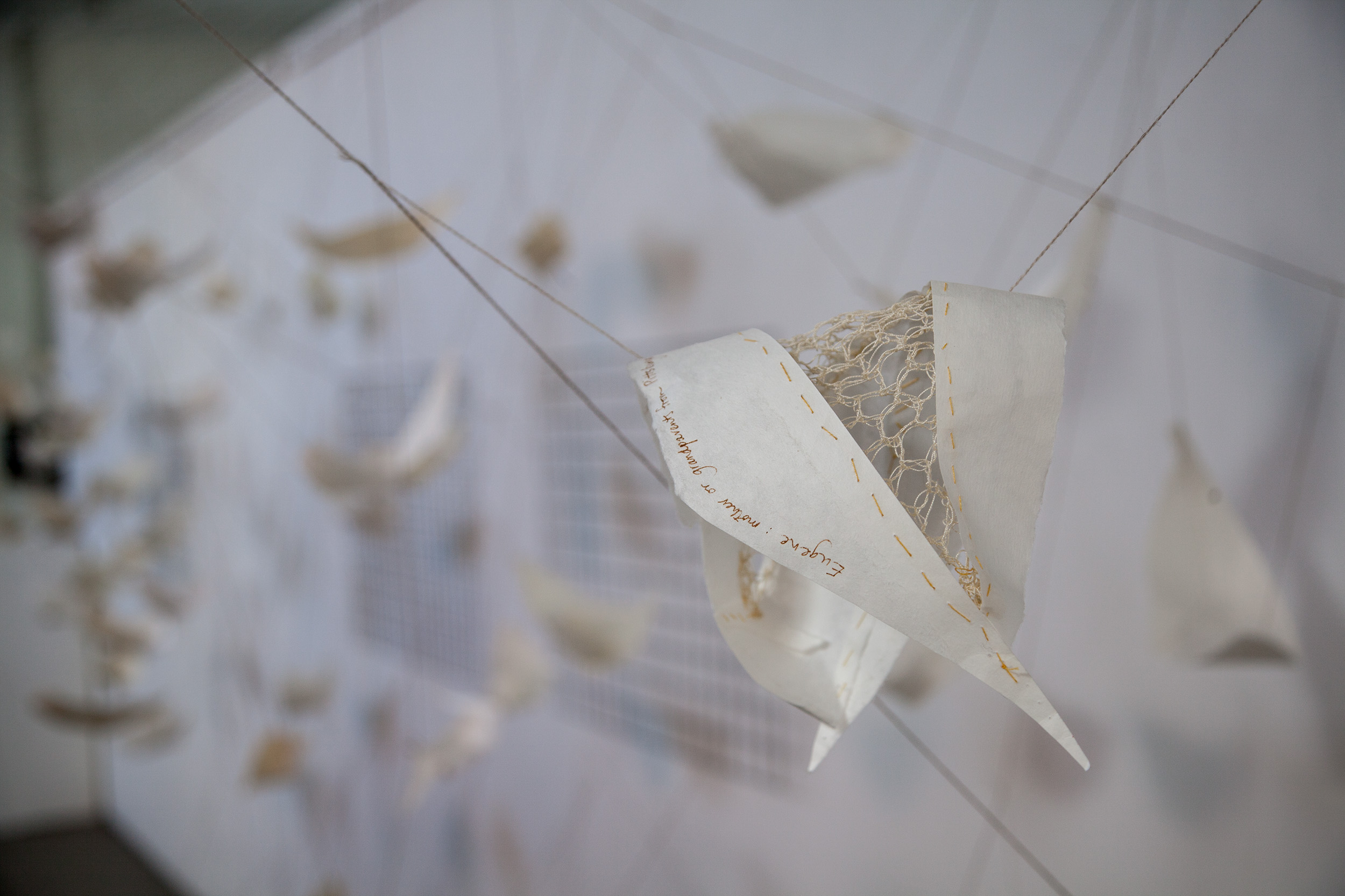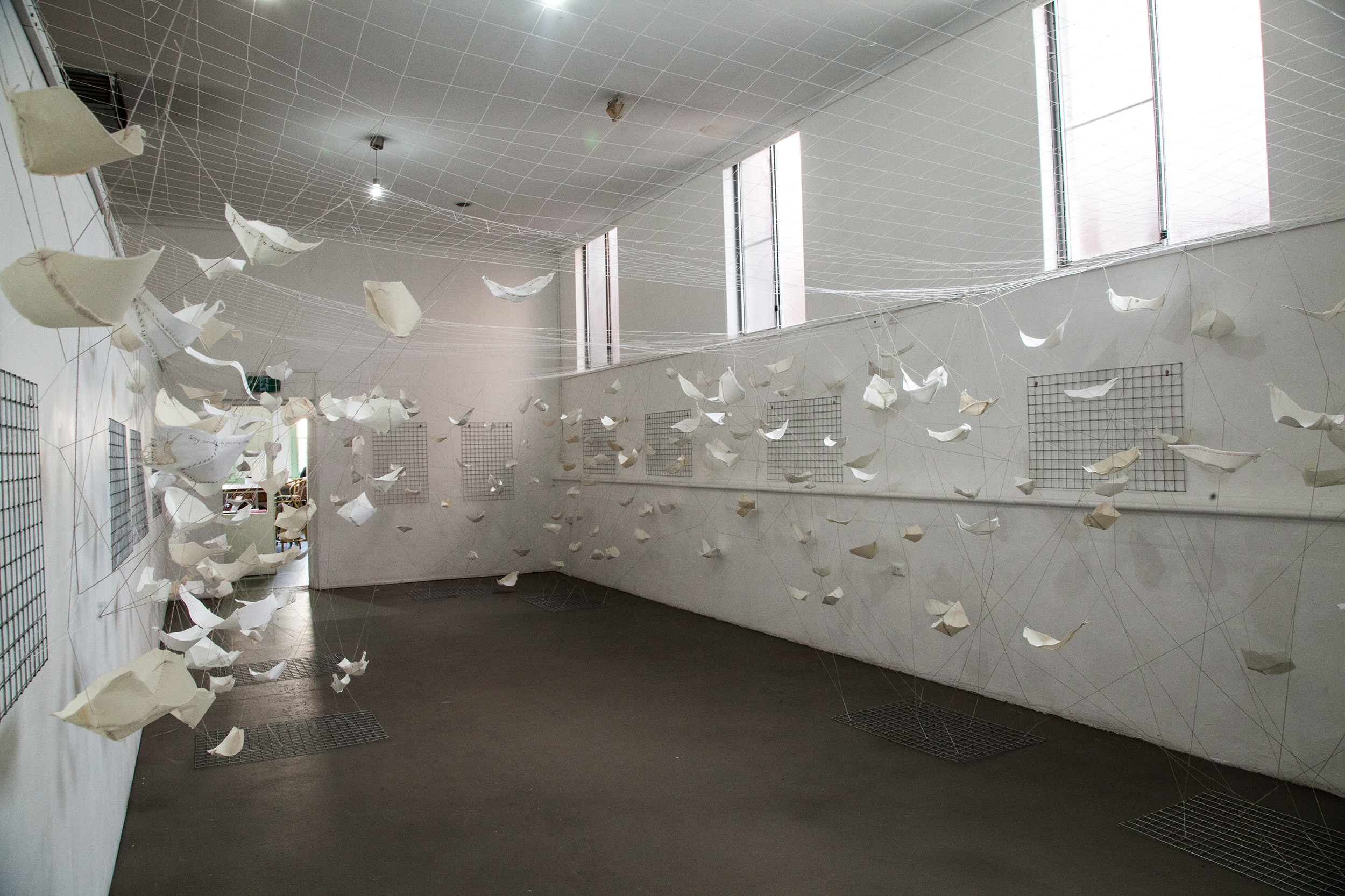























Castaway
Catalogue Essay
’Castaway’ is an installation of paper vessels bearing arrival tales and is the second outcome of my time-based project of letter writing (‘Dear Prime Minister’). In both projects I use repetition of making, paper and writing. Since July 2016 I have been handwriting a daily letter to the Prime Minister about the refugees in Australia’s offshore detention centres. My intention is to bear witness to the refugees’ situation, to add voice to a political protest and to practise art as an act of resistance. In ‘Castaway’ I use the gallery as a space for exchanging stories of migration. Participants have been asked “how did you get here?” and each respondent’s tale of their own or their ancestors’ arrivals in Australia has been written on paper vessels and hung in the gallery.
Both ‘Castaway’ and ‘Dear Prime Minister’ are attempts to contribute to resistance, without knowing either what the outcomes of the art or the outcomes of resistance will be. To work in such a state of unknowing is to be in a liminal space. Liminality has been a recurring theme in my previous work including in an imagined threshold between British and colonial homes (‘Clean Sheet’, 2011), and between social media posts and travel memories in seven stitched works (Reconfigure, 2016). The subject of ’Castaway’ is the liminal space of memories of migrating.
The liminality of migrating is the space between the foreign and the local, between outside (away) and inside (here). These are not balanced, reciprocal states: inside is contained and known while outside is abstract, strange, unbounded. The threshold between inside and outside is a transition process between two inequivalent states. If that threshold is treated not as relative but as a fixed opposition it becomes aggressive. When liminality is not acknowledged those in its transitional, vulnerable state are regarded as outsiders or deviants and are endangered instead of being nurtured through the process. Those in transition between established states, such as teenagers, the ill, migrants or people seeking refuge, are cast as ‘other’. The more tightly the boundaries are established and enforced the more fearsome seem those on the ‘other’ side. Paradoxically, the ‘insiders’’ sense of safety and security decreases as they exert more effort to define and exclude the ones (‘outsiders’) who are not allowed in.
As a country where all inhabitants except the Aboriginal Australians are migrants or descendants of migrants we don’t speak much of our arrival stories and we don’t welcome new arrivals warmly. Do non-Indigenous Australians assert their own successful crossing of the liminal space between ‘immigrant other’ to ‘Australian’ by enforcing newer arrivals’ ‘otherness’ and thus establish their own ‘insider Australian-ness’?
Yet as Ali Cobby Eckermann writes of the white man Jack in her verse novel, the earliest white arrival stories contain the same tragic gap between expectant hope and messy reality as do many subsequent arrivals:
‘… luck has evaded every choice
in his prospect for comfort and companionship
he lives in the memory of his childhood
before the famine and fighting
oh laddie alas the misfortune
found in a foreign land
yet not the soul song fade
from your mother’s tongue of glad’
Do non-Indigenous Australians fabricate a narrative of right decisions and just outcomes to deny the failures, tragedies and foundational genocide and injustice of colonial presence here? This project attempts to unfold a new surface to write on, away from the stifling binary us/other discourse we ricochet into each other across. ‘Castaway’ is a space of multiple perspectives and connections where many stories of origin or arrival in Australia can coexist.
‘Two truths approach each other. One comes from within,
one comes from without - and where they meet you have the chance
to catch a look at yourself.
Noticing, what is about to happen, you shout desperately: “Stop.
Anything, anything, as long as I don’t have to know myself.”’ —Tomas Tranströmer, ‘Preludes II’
As haphazard as an arrival story is the trajectory of this installation. At a residency in rural Sweden in 2014 I played with paper, tearing and stitching it into hollow forms. After returning home I set the forms aside, unresolved and too distant from their source. Omid Masoumali’s death after he set himself on fire and was not medically treated on Nauru last year was one of the events that prompted me to start writing to the Prime Minister. But I wanted to find a way to consider the broader issue, with voices of Australians speaking their own stories. I wondered if there is something about our arrival stories which explains how we came to be a country which causes people to set themselves on fire. If we tell our stories and listen to others’, can we dissolve some of the polarity and weave a new field to operate in? Those exploratory paper forms I stitched in Sweden seemed able to carry the simple stories, evoking the improvised, contingent, imperfect journeys we’ve made here. Walking through the gallery’s network of suspended vessels immerses viewers in a layering of space and time, where last year’s plane arrival from Asia may tie up near a passenger from a nineteenth century English ship. Whatever our opinions of asylum seekers, we all have a story of origin or arrival to tell.
June, 2017
Castaway catalogue
The 12-page catalogue can be down-loaded here.
If you would like a printed copy, contact me by email at ruth.halbert@gmail.com and I will post one to you.